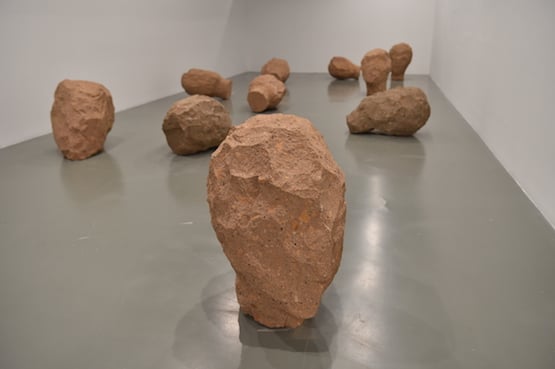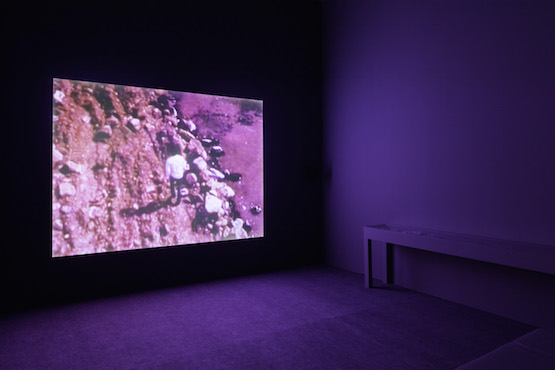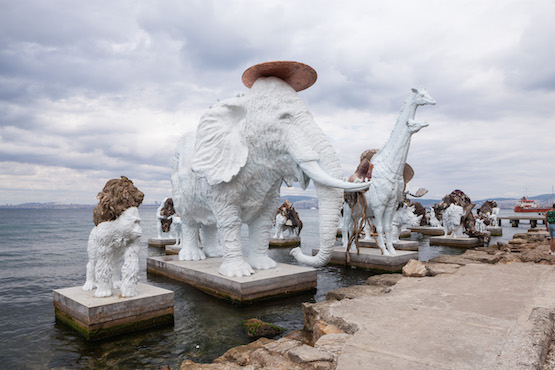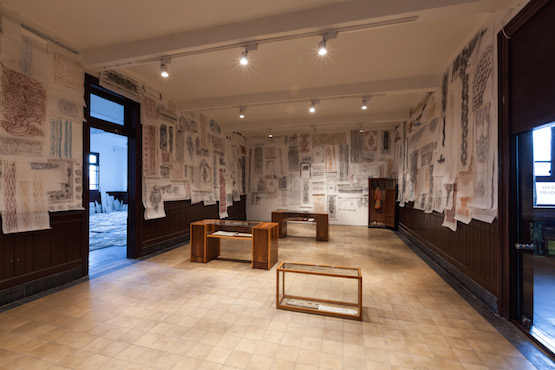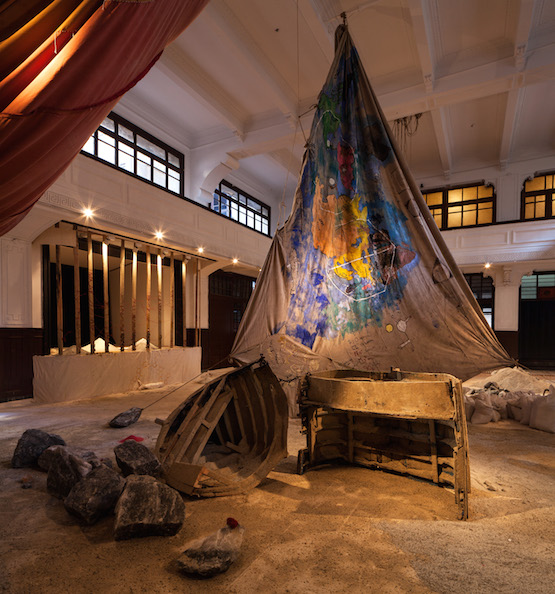A Pinch with Salt: A Report from the 14th Istanbul Biennial
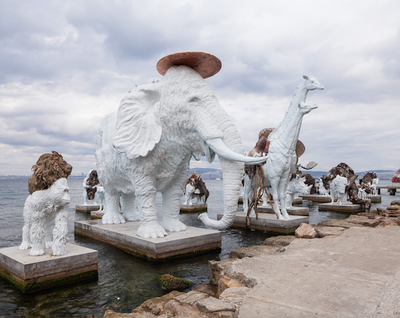
My first impression of the 14th Istanbul Biennial, Saltwater: A Theory of Thought Forms, was that its curator (or 'drafter'), Carolyn Christov-Bakargiev (CCB), must dislike her audience. If this is indeed the case, it would be a terrible shame for the Istanbul Biennial and its visitors, but worse still for its artists, all of whom thankfully have practices that are rigorous enough to withstand the impact of an exhibition some have described at worst as impossible, at best as 'nice'. The common use of the latter adjective during the opening days led one commentator to recall the Latin root of the word: nescius, 'ignorant, unaware', or 'not-knowing'. This etymology worked well when thinking about the 14th Istanbul Biennial, which, even at its most coherent, is difficult to grasp.
Physically, this is due to the dispersion of venues (the widest in Istanbul Biennial’s history, with some 36 locations on the European and Asian sides of the Bosphorus, from the Black Sea to the Sea of Marmara), and the unhappy fact that many who visited simply did not have the time or the resources to see everything. (I heard one Greek journalist accuse Christov-Bakargiev of, 'being out of touch with the struggles of those working in the arts', after the curator told her that if she was privileged, she could come back to Istanbul again to see more, and that if she wasn’t local, then this biennial was not for her.)
Conceptually, the biennial’s theme—essentially about framing the idea of materiality as a vast and fluid interweaving of human, animal, and natural energies and forms—appears to re-hash the framework of Christov-Bakargiev’s dOCUMENTA(13) in 2012, which was about 'unfreezing positions' through an exhibition conceived as 'an unfolding organism'. (When I asked CCB about this similarity in an earlier Ocula interview, she dismissed both curatorial themes as decoys for 'you'—'you' being the audience, I assume.)
Sonia Balassanian, Heads, 2015. Image courtesy Istanbul BiennialOf course, it could be argued that our inability to grasp the totality of our existence is part of Christov-Bakargiev's curatorial approach: a position in which the curator insists we accept an almost preordained failure to see and understand everything. This all fits with the drafter's dOCUMENTA(13), for which she released pictures of herself posing in various locations in lieu of a press release, and which was made so vast that it was almost impossible for anyone—except the curator herself—to see it all. But in contrast to the success of dOCUMENTA(13), the theme of the 14th Istanbul Biennial feels more like a cop-out than a revelation. In the guide, for instance, which one curator labeled 'poetic and escapist', information has been forsaken for Christov-Bakargiev’s poetry, which some accused of asserting a kind of empty gravitas.
But despite the grumbling (which, admittedly, had much to do with CCB’s antics during the opening week), this is still a biennial worth engaging with. It essentially begins in the basement galleries of the Istanbul Modern, where a kind of mission statement within a mission statement is located in a room called The Channel. This is the biennial’s 'brain'—as it was called in dOCUMENTA(13)—where the exhibition’s themes are distilled. Nature, in all its manifestations, is evidently a key concept: pages taken from the works of Leon Trotsky, Charles Darwin, and Jacques Lacan mingle with works including Patrick Blanc’s 22 Drawings for Vertical Gardens produced between 1986 and 2015, photographs of flowers by Karl Blossfeldt, a collection of 19th century vases, and a room with an ornate floral-inspired musical lectern by Song Ming-Ang in Something Old, Something New (2015). Central to this grouping are diagrams from Annie Besant and Charles Webster Leadbeater’s 1905 theosophical book, Thought-forms. The book informs the premise of the biennial: to present a way of thinking about abstraction beyond the ordained lenses of the historical canon.
From The Channel, visitors move into a corridor where The Prophets (2013) by Richard Ibghy & Marilou Lemmens is installed—a vast 13-metre table on which marvellous little three-dimensional graphs visualising human data taken from academic and scholarly journals are placed. To the artists, these graphs reflect the prophecies of the economists—thought forms, basically, which is to suggest that we are all potential authors of such formal prophecies. This is underscored in the archive of pioneering mathematician and physicist, Frederik Carl Mulertz Stormer—an amateur photographer obsessed with capturing the lights of the aurora borealis—presented in another biennial venue, ARTER, where Christine Taylor Patten’s amazing series of tiny drawings depicting some kind of celestial event in micro/macro 1001 drawings (1998–2015) are also presented (among other works).
Richard Ibghy & Marilou Lemmens, The Prophets, 2013. Image courtesy the Istanbul BiennialThe sentiments of The Channel are furthered in the rest of Istanbul Modern’s basement galleries, with works such as Giuseppe Pellizza da Volpedo’s Il Quarto Stato (The Fourth Estate) (1901), a large oil on canvas painting of striking workers presented next to Artıkişler Kolektifi’s series of videos documenting recent workers’ movements in Turkey. Vernon Ah Kee’s powerful 4-channel video installation Tall Man (2010), which covers the plight of aborigines in Australia, is screened near Aboriginal works telling the story of the 20th century Aboriginal struggle with reference to both Wonggu Mununggurr’s message sticks from 1935, and the Yirrkala Bark Petitions from 1963.
Ellen Gallagher’s video Drowned Forest and its storyboards, produced with Edgar Cleijne between 2014 and 2015, are presented next to a series of Gallagher’s abstract canvases with surfaces built up from enamel, rubber, ink and paper, including Kapless Wonder and Phantasie (2015)—works that encapsulate what Christov-Bakargiev had in mind when formulating a theme favouring geological over geometric abstraction. This dialecticalsentiment (salt, Christov-Bakargiev explains, at once nourishes and destroys) is furthered in Nikita Kadan’s 2015 installation The Shelter: a stage with two floors presenting the interior of a museum recently destroyed in Ukraine. On the top level, taxidermy animals that survived shelling are presented in a room in which broken glass breaks through a tyre barricade, while on the lower level, a small greenhouse produces celery.
From this, we move to an assemblage of LIFE magazine covers by Sarkis, covering two walls in images of riots, celebrities and other scenes that commingle into a kind of grand, tragic, and political view of the world, which brings us back to Christov-Bakargiev’s all-encompassing frame, constructed to explore the present and all it encapsulates, from the environmental to the political. In other words, everything—take that as you will.
Robert Smithson, Spiral Jetty, 1970. 16mm film on video, sound. Photo by Sahir Ugur Eren. Courtesy the artist and Istanbul BiennialBut despite the quality of work on show, the exhibition at the Istanbul Modern (and The Channel in particular) fell flat for many spectators. A contrast to the spectacular installations at Büyükada Island where excellent works by artists such as Susan Philipsz and William Kentridge feel like markers on what is essentially a pilgrimage to the house Leon Trotsky lived in during a period of exile in the 1930s. Here, visitors are treated to Adrián Villar Rojas’ The Most Beautiful of All Mothers (2015): life-sized animals made from what looks like the brightest, whitest porcelain, all bearing animal appendages made from more organic materials (burlap sacks and woven fabrics) and installed on the water front.
Reaching Villar Rojas’ works felt like a reward of some sort—a kind of 'see where your toils will lead you?' moment that left some in a state of childlike awe (this writer included), but riled others. One Istanbulite I encountered on my journey noted a marked disconnect between the works on show on Büyükada and Christov-Bakargiev’s insistence that the biennial is for the people of Istanbul. Certainly it was noted that the beautiful installation in the 19th century Rizzo Palace by Ed Atkins, Hisser (2015)—a two-channel video installation—felt more geared to an international crowd, there being no Turkish subtitles provided to its English soundtrack. Perhaps then the work might have been more relevant, given that it tells the story of a man’s final moments before his house fell into a sinkhole as he slept in a dilapidated building.
Adrián Villar Rojas, The Most Beautiful of All Mothers, 2015. Site-specific installation. Organic and inorganic materials. Photo by Sahir Ugur Eren. Courtesy the artist and Istanbul BiennialBut despite all this, there is something to be said about an Istanbul Biennial that has awoken (most of) this city’s spectres at once. Take the acknowledgement of the Armenian genocide on the year of its centenary—what you might say lies at the heart of this exhibition. (In this frame, it could be surmised that all other works and locations act as buffers around which such a heart might be protected.) A large number of Armenian artists and projects are presented, some in Armenian venues. One location included in the guide actually declined to participate in the exhibition: the Palace of St. Eugène, originally built as an orphanage in 1868 and which later became the atelier of the Armenian plasterer Garabet Cezayirliyan. The building is now home to an archive of art nouveau models by Cezayirliyan’s former apprentice, Kemal Cimbiz, many of which are being shown alongside casts by Cezayirliyan and new moulds by Michael Rakowitz as part of his work, The Flesh Is Yours, The Bones Are Ours (2015), at the Greek School. The title of the work references a customary Turkish saying reflecting the master-student relationship, although for Rakowitz the expression cuts deeper—many of Istanbul's buildings were created by Armenian architects and craftsmen, after all.
At the Greek School, entire floors are also given over to such installations as Prabhakar Pachpute’s installation on the labour of miners, What We Have Left is the Blue Water (2015), and Anna Boghiguian’s installation of Egyptian sails and piles of salt which traces the history of the salt trade. The school building points to another bloody chapter in Turkey’s history: the 1923 Lausanne Treaty, which, as Belinda Cooper writes, 'regularized the expulsions of Greek Christians from Turkey and authorized reciprocal expulsions of a smaller number of Muslims from Greece'. Indeed, context is thick in Istanbul. So much so, that even the absence of work addressing the Kurdish situation here (what you might call a glaring omission in this supposedly total view) was remedied at the last moment. Just before the exhibition opened, two Vice journalists were arrested while filming clashes between the PKK and Turkish police in Diyarbakir, and shortly after the opening, Armenian neighbourhoods were attacked in Istanbul as a result of growing frustrations among Turkish nationalists.
Michael Rakowitz, The Flesh is Yours, The Bones Are Ours, 2015. Photo by Sahir Ugur Eren. Courtesy the artist and Istanbul BiennialThought forms, following Christov-Bakargiev’s sprawling logic, are not only art works: they are traces, memories, sounds, events, responses, bodies, forces, actions and occurrences. This was demonstrated in Haig Aivazian’s performance Wavy is the Sea of Bolis, O Mother performed by The Choir of Beyoğlu Holy Trinity Armenian Church in the Greek School. It involved a small choir moving up a staircase from the ground floor of the school to the top—as if the building were the pipe of an organ—performing a song by Armenian-Turkish oud master and genocide survivor Udi Hrant Kenkulian. Composed to reflect the collapse of the Ottoman Empire and the establishment of the Turkish Republic, it is in Aivazian’s performance that the 14th Istanbul Biennial truly expresses its theme. It recalled—to this viewer at least—a famous song written by Greek composer Nikos Zoudiaris, in which lyrics talk about wanting to drink the entire Bosphorus in a desperate act of relief because the borders of the world are changing within whomever sings the lament. Indeed, saltwater is never static or stable, after all; it moves, divides, connects and absorbs.
In that regard, Christov-Bakargiev made her audience drink saltwater for the 14th Istanbul Biennial. As she warned in her statement, moving through the city for this exhibition will be like moving on saltwater. It makes sense: reality’s pill is rarely sweet. At the Italian School, for instance, Seductive Exacting Realism by Irena Haiduk requires visitors to sit in the dark attic of the school to listen to a 35-minute conversation based on Haiduk’s interviews with Srdja Popovic, a former leader of a non-violent student movement responsible for deposing Serbian autocrat Slobodan Miloševic. Described as 'an excursion into the deep waters of revolutionary desire', visitors cannot leave the room once they enter. At one point, an explanation for how people can organise politically soon becomes a list; more like a bureaucratic breakdown of a late-20th century political movement. The experience of Haiduk’s work—in which the viewer submits to a controlled environment—is not unlike that of the 14th Istanbul Biennial itself. Never at any point does the viewer forget that Christov-Bakargiev—quoting her —is 'the one in charge'.
This brings me to my final stand on the 14th Istanbul Biennial. To quote Roberta Smith’s 2012 dOCUMENTA(13) review, this was 'an immense, unruly organism of a show' that is at once inspiring, insufferable, 'predictable, meticulous and sentimentally precious'. I thought about Smith’s review a lot, in fact; especially the part about dOCUMENTA(13) being an exercise in 'incomprehensible, viewer-defying vastness' that 'perpetuates an old model' of 'the curator as all-seeing-god, on a disheartening scale'. While I disagreed with Smith then, I agree with her now. With everything happening in the world, it is amazing that big is still seen as better in the arts—even when no good justification is given as to why such scale is necessary, except maybe for the fact that the spectacle is still an effective method of stunning an audience into submission.
Anna Boghiguian, The Salt Traders, 2015. Textiles, wax, watercolour, gouache, wood, cankiri salt, salts, sand, voice and sound of waves and seagulls. Photo by Sahir Ugur Eren. Courtesy the artist and Istanbul Biennial.
But that does not mean I didn’t get anything out of this Istanbul Biennial. In fact, it was only when thinking about Ayreen Anastas and Rene Gabri’s installation/residency Society of the Friends of Parrhesia, staged at the former offices of the Armenian newspaper Agos, that things came together. It was at this location that Agos editor Hrant Dink was assassinated in 2007, and where the artists are now exploring the question of truth-telling not only as a necessary risk, but as an obligation. This reminded me of my Masters year at Goldsmiths, during which Irit Rogoff set our class the grand task of deconstructing parrhesia within the vague frame of neoliberalism. The assignment was met with great frustration, given the absence of our tutor to guide us and what we felt were limited parameters: things felt too controlled, problematic, hypocritical, and indulgent. Yet the assignment resulted in an intense lesson we did not really fathom until the final presentation, when we expressed our responses to the group; it was only once we came together to speak that things began to make sense.
In a similar way, Christov-Bakargiev’s 14th Istanbul Biennial was meant to provoke conversations, debates, and—at times—shrill reactions. In fact, this was the one thing that did not change about this edition of the Biennial, when compared to those that came before it: the discussions it produced, which says something about how Saltwater: A Theory of Thought Forms will fit into the Istanbul Biennial’s history. There is no doubt the 14th Istanbul Biennial produced the conditions within which heated—and necessary—discussions took place. To this end, you might say Christov-Bakargiev had her reasons. —[O]

